| Leptoceratops Temporal range: Late Cretaceous | |
|---|---|

| |
| A restoration of Leptoceratops gracilis | |
| Scientific classification | |
| Kingdom: | Animalia |
| Phylum: | Chordata |
| clade: | Dinosauria |
| Order: | †Ornithischia |
| Parvorder: | †Coronosauria |
| Family: | †Leptoceratopsidae |
| Genus: | †Leptoceratops Brown, 1914 |
| Species: | L. gracilis |
| Binomial name | |
| Leptoceratops gracilis Brown, 1914 | |
Leptoceratops (meaning 'lean-horned face' and derived from Greek 'lepto-/λεπτο-' meaning 'small', 'insignificant', 'slender', 'meagre' or 'lean', 'kerat-/κερατ-' meaning 'horn' and '-ops/ωψ meaning face), is a genus of primitive ceratopsian dinosaurs from the late Cretaceous Period (late Maastrichtian age, 66.8-66.038 Ma ago) of what is now Western North America, at the same time as their giant relatives of the genus Triceratops. Their skulls have been found in Alberta, Canada and in Wyoming. They could probably stand and run on their hind legs. Analysis of forelimb function indicates that even though they couldn't pronate their hands, they could also walk on four legs.
Leptoceratops was around 2 metres (6.6 feet) long and could have weighed anywhere between 68 to 200 kilograms (150 to 440 lbs).
Description[]
Discovery and Species[]

Phalanges of the pes, holotype (AMNH 5205)
The first small ceratopsian named, Leptoceratops was discovered in 1910 (and described four years later), by Barnum Brown in the Red Deer Valley in Alberta, Canada. The first specimen had a part of its skull missing, however there have been later well-preserved finds by C. M. Sternberg in 1947, including one complete fossil. There has been later material found in 1978 in Bighorn Basin in northern Wyoming. The type species is Leptoceratops gracilis. In 1942, material collected in Montana was named Leptoceratops cerorhynchos but this was later renamed Montanoceratops.
Classification[]
Leptoceratops belonged to the Ceratopsia (the name is Ancient Greek for 'horned face'), a group of herbivorous dinosaurs with parrot-like beaks that thrived in North America and Asia during the Cretaceous Period. Within this group, it has been placed either in Protoceratopsidae or its own family Leptoceratopsidae.
Paleobiology[]
Diet[]
Leptoceratops, like all ceratopsians, was a herbivore. During the Cretaceous Period, flowering plants were "geographically limited on the landscape", so it is likely that this dinosaur fed on the predominant plants of the era: ferns, cycads and conifers. It would have used its sharp ceratopsian beak to bite off the leaves or needles.
In Popular Culture[]
- Leptoceratops appears in the playstation game of The Lost World: Jurassic Park when you play as the Compsognathus. It can be found in the first two levels, High Ridge and Rainforest where it guards the DNA. Due to its large size, compared to the player, it can do a large amount of damage to the player although successfully killing it does reward you with a lot of health. The main attack of the Leptoceratops is a bucking-goring motion making head on attacks difficult although an attack from behind can do a large amount of damage. It is believed that Leptoceratops could stand and run on its hind legs as well as walk on all fours as it does in the game.
- It’s seen as an Illustration at the beginning of The Lost World (1998 film) in the opening credits along with the Centrosaurus “Digital Visual Effects Image Animation & Big Bang Animation”. Some say it’s an Unknown Ceratopsian.
- It made it’s 1st yet brief appearance in the National Geographic Dinosaur Documentary “Dino Autopsy” at the very beginning.
- It was originally going to appear in the upcoming game Saurian, but was scrapped due to it not being found in the particular time period the game takes place in.
Gallery[]
Leptoceratops/Gallery